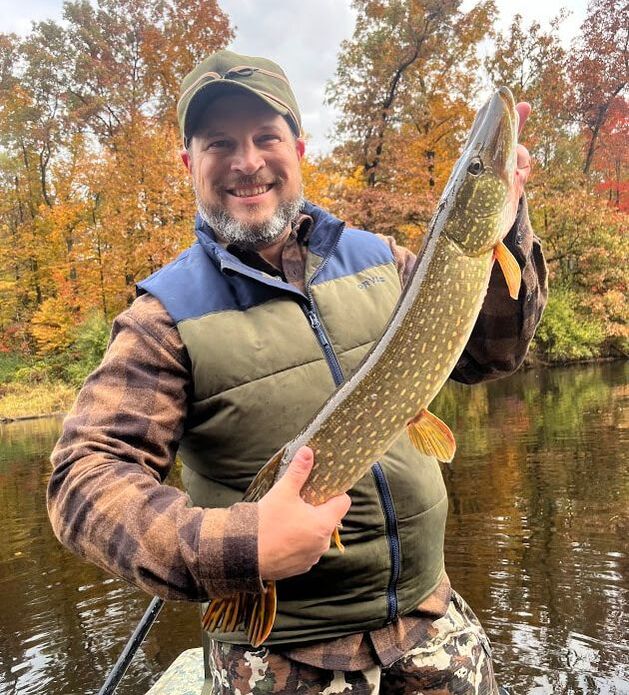|
By Drew YoungeDyke This Michigan Outside column was originally published in the June 2019 issue of Woods'N'Water News. The trail wound uphill into the forest and I found a natural stride which made me feel like our ancient ancestors who persistence hunted African antelope, running them to exhaustion over long distances before killing and eating them. At least that’s what I pictured in my head up until about mile 12 of my first ultramarathon, when leg cramps kicked in. I finished the final 19 miles alternating between walking and a slow jog, but I crossed the finish line having run 31 miles, 50K, on a trail through our public lands.
Just a few years ago, running an ultramarathon would have seemed impossible. When I turned 35, I was fifty pounds heavier, never ran, drank too many carbonated beverages, and ate like I had the metabolism of the high school athlete I used to be. Inspired by the burgeoning hunter-athlete movement popularized by Cameron Hanes, I ran the trail in the nature area across the street from my house one day after work – for one mile. But I repeated that every day for two weeks until it was a habit, and that first mile set me on a path to finding fitness and eating healthier. Endurance and physical fitness used to be a critical component of hunting. Dr. Dan Liebermann, a Harvard evolutionary biologist, theorizes that we actually evolved through persistence hunting. Maybe that’s why I feel the same instinct when I’m trail running as when I’m still hunting with a recurve. At some point in our evolutionary history, though, hunting and fitness diverged. I suspect that was more recently, though, as we started relying more on ORV’s to take us to blinds to sit all day. But even for stationary hunters who use motorized transportation, a healthy lifestyle can lead to more seasons afield as you age. And trail-running is a natural fit for hunters and anglers looking to improve their physical fitness – after all, we already know our way around the woods. That’s what I loved about trail-running at first – the setting. Running on roads and sidewalks was always too monotonous to keep me running on previous false starts over the years, but every bend of the trail holds something new – a doe with fawns, scurrying squirrels, birds of every color, and the consistently changing conditions of the woods throughout the seasons. Soon I was running three miles, then six. My footwork improved to avoid roots and hurdle fallen logs and large rocks in the trail. My ankles grew stronger. And when the fall came, I found that I could still hunt longer across the public land hills I hunt without getting exhausted. That year I killed my first deer with a bow and then my first buck with a rifle, a three-and-a-half year old public land eight-point, both by still hunting. The next year I ran my first trail race, a 5K held on the field archery course at the Tomahawk Archers club in Temperance, Michigan. I also entered my first Train To Hunt competition that year, and the next year I added a 10K race, made the Train To Hunt national finals in the traditional bow division, and won a 5K race in Boulder, Colorado. Last year I ran my first half-marathon trail race and then my first ultramarathon (anything longer than a marathon) at Run Woodstock, which uses parts of the Pinckney State Recreation Area. As my endurance builds up over time, I continuously want to push myself to see how far I can go. Running those distances isn’t necessary to improve your fitness, though: all that takes is to do more than you’re currently doing right now. Before you start trail-running, the dormant lawyer in me is going to say to check with a medical professional to make sure that you can. Okay, now that’s out of the way. The next step is figuring out where to run. Luckily, we’re pretty blessed with abundant public land trails in Michigan. My favorites are the Potowatomi Trail in the Pinckney State Recreation Area, combining the Orange, White, and Blue Trails at Bald Mountain State Recreation Area, the Shingle Mill Pathway in the Pigeon River Country State Forest, and the Escarpment Trail in the Porcupine Mountains Wilderness State Park. Michigan boasts 12,500 miles of trails and pathways, though, so there’s likely one near you. Most trailheads require a Recreation Passport on your vehicle to enter and park. Gear for trail-running starts with the shoes. Trail running shoes will have more aggressive tread and often a rock guard insert. Each brand and model fits and functions just a little different. Drop refers to the distance from the heal to the toe; I prefer the Altra Lone Peak model because they have zero drop from the heel to the toe, which I think helps me maintain a natural forefoot strike, instead of striking the ground with my heels, which can lead to knee issues. Some runners prefer minimalist or “barefoot” shoes; others prefer shoes with thick, cushioned soles like those made by Hoka One One. Running clothes can be simple – I started running in a tee shirt and basketball shorts. Now I use Patagonia Nine Trails shorts with a built-in brief and their Capilene tee with odor-reducing technology because I can wear them on multiple runs before I have to wash them. For socks, I prefer merino wool running socks from Smartwool, which keep my feet dry by wicking sweat. A simple foam trucker hat will keep the sun out of your eyes and your head cool. If I’m running a longer distance, I carry water in a hydration bladder backpack made specifically for running from Ultimate Direction. If it’s cold, snowing, or icy, I’ll wear nylon running pants, a hooded fleece top like the Patagonia R1, a merino wool hat, light gloves, and trail gaiters or running crampons over my shoes. Trail running is inherently slower than road running; you have roots and rocks – and sometimes snakes – to watch out for, the terrain is more varied with hills and valleys, and the scenery is better. Don’t worry about how fast you run at first, or how far. Take it slow and pick a distance you can manage. If you’re running an out-and-back, remember to turn around at half that distance. Unlike road running, a trail through the woods can lead you far from any roads. If you run five miles out, you’re going to have to run, walk, or crawl the five miles back. But at the heart of it, it’s just running through the woods, as instinctual to our species as stalking a deer with a traditional bow. Other than persistence hunting, trail running doesn’t have a direct correlation to the killing part of hunting. The endurance it builds, though, can help you sit out the cold on stand, keep up with your dog in the grouse woods, follow your hounds to a bear, drag out your deer with less risk of a heart attack, or, like me, still hunt all day across public land hills. And do so into the later years of your life. Who knows: You might even start running trails just for the fun of running trails. |
AUTHOR
Drew YoungeDyke is an award-winning freelance outdoor writer and a Director of Conservation Partnerships for the National Wildlife Federation, a board member of the Outdoor Writers Association of America, and a member of the Association of Great Lakes Outdoor Writers and the Michigan Outdoor Writers Association.
All posts at Michigan Outside are independent and do not necessarily reflect the views of NWF, Surfrider, OWAA, AGLOW, MOWA, the or any other entity. ARCHIVES
June 2022
SUBJECTS
All
|


 RSS Feed
RSS Feed